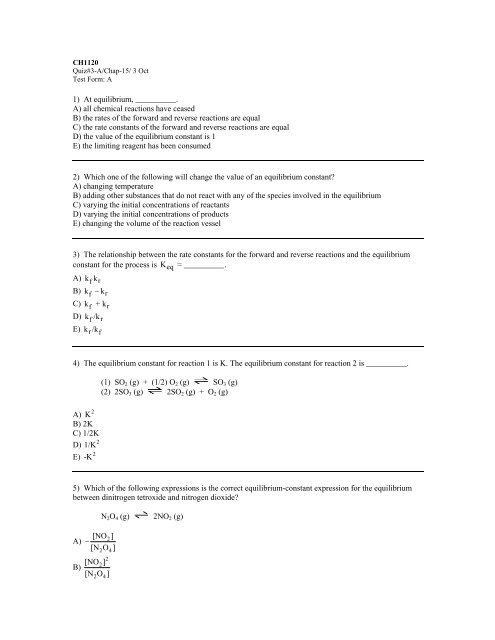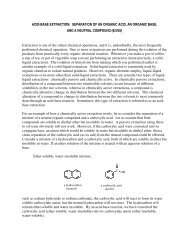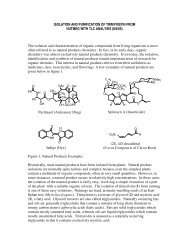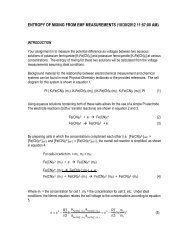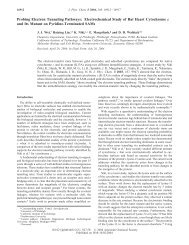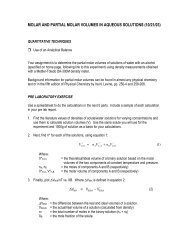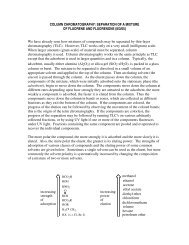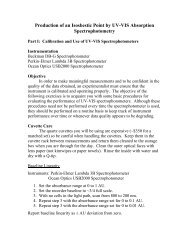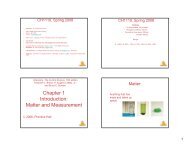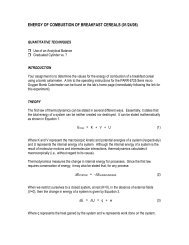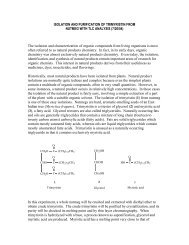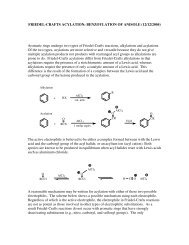1) At equilibrium, ______. A) all chemical reactions have ... - Chemistry
1) At equilibrium, ______. A) all chemical reactions have ... - Chemistry
1) At equilibrium, ______. A) all chemical reactions have ... - Chemistry
Create successful ePaper yourself
Turn your PDF publications into a flip-book with our unique Google optimized e-Paper software.
CH1120Quiz#3-A/Chap-15/ 3 OctTest Form: A1) <strong>At</strong> <strong>equilibrium</strong>, __________.A) <strong>all</strong> <strong>chemical</strong> <strong>reactions</strong> <strong>have</strong> ceasedB) the rates of the forward and reverse <strong>reactions</strong> are equalC) the rate constants of the forward and reverse <strong>reactions</strong> are equalD) the value of the <strong>equilibrium</strong> constant is 1E) the limiting reagent has been consumed2) Which one of the following will change the value of an <strong>equilibrium</strong> constant?A) changing temperatureB) adding other substances that do not react with any of the species involved in the <strong>equilibrium</strong>C) varying the initial concentrations of reactantsD) varying the initial concentrations of productsE) changing the volume of the reaction vessel3) The relationship between the rate constants for the forward and reverse <strong>reactions</strong> and the <strong>equilibrium</strong>constant for the process is K eq = __________.A) kfkrB) kf− krC) k f + krD) k f /krE) k r/kf4) The <strong>equilibrium</strong> constant for reaction 1 is K. The <strong>equilibrium</strong> constant for reaction 2 is __________.2KA)B) 2KC) 1/2K2D) 1/K2E) -K(1) SO 2 (g) + (1/2) O 2 (g) SO 3 (g)(2) 2SO 3 (g) 2SO 2 (g) + O 2 (g)5) Which of the following expressions is the correct <strong>equilibrium</strong>-constant expression for the <strong>equilibrium</strong>between dinitrogen tetroxide and nitrogen dioxide?N 2 O 4 (g)2NO 2 (g)[NO 2]A) −[N O ]2 42[NO 2]B)[N O ]2 4
[NO 2 ]C)[N O ]22 4D) 2 2 4E)[NO ][N O ]2[NO][NO]2 2 46) The expression for K p for the reaction below is __________.4CuO (s) + C H 4 (g)CO 2 (g) + 4Cu (s) + 2 H 2 O (g)PA) 4PCOCH P2H 22[Cu]PCO P2 HB)2O2[CuO]4P CHPCOP2 HC) 2 O2PCH 4PCOP2 HD) 2 O2PCuOPCH E) 4PH CO2O2P247) The <strong>equilibrium</strong>-constant expression for the reactionTi (s) + 2Cl2 (g)TiCl4 (l)is given byA)B)C)[TiCl4(l)][Ti(s)][Cl (g)][Ti (s)][Cl2(g)][TiCl4(l)][TiCl (l)][Cl24(g)]D) [Cl2 (g)]-2E)[TiCl24[Ti(s)][Cl2(l)]2(g)]228) How is the reaction quotient used to determine whether a system is at <strong>equilibrium</strong>?
A) The reaction quotient must be satisfied for <strong>equilibrium</strong> to be achieved.B) <strong>At</strong> <strong>equilibrium</strong>, the reaction quotient is undefined.C) The reaction is at <strong>equilibrium</strong> when Q < Keq.D) The reaction is at <strong>equilibrium</strong> when Q > Keq.E) The reaction is at <strong>equilibrium</strong> when Q = Keq.9) For the endothermic reactionCaCO3 (s)CaO (s) + CO 2 (g)Le Chätelier's principle predicts that __________ will result in an increase in the number of moles of CO 2 .A) increasing the temperatureB) decreasing the temperatureC) increasing the pressureD) removing some of the CaCO 3 (s)E) adding more CaCO 3 (s)10) The effect of a catalyst on an <strong>equilibrium</strong> is to __________.A) increase the rate of the forward reaction onlyB) increase the <strong>equilibrium</strong> constant so that products are favoredC) slow the reverse reaction onlyD) increase the rate at which <strong>equilibrium</strong> is achieved without changing the composition of the <strong>equilibrium</strong>mixtureE) shift the <strong>equilibrium</strong> to the right
Quiz#3A:Answer Key1) B2) A3) D4) D5) B6) C7) D8) E9) A10) D


